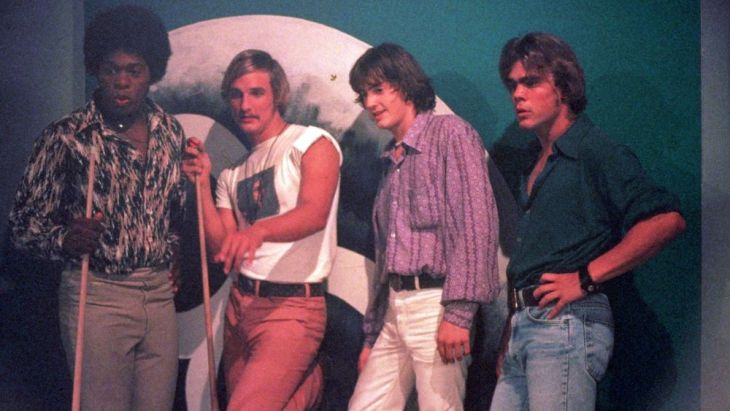Richard Linklater’s films serve as a window into nineties slacker culture and youth life in the seventies. Media researchers at UiO have now published the book about the director behind 'Dazed and Confused' the 'Before' Trilogy.
The movie ‘Dazed and Confused’ from 1993 describes the life of youth in the 1970s in Austin, Texas. From left: Jason O. Smith, Matthew McConaughey, Jason London and Sasha Jenson.
“Film is not necessarily a reflection of someone’s reality, but rather their experience of what it is like to live right there and then. It imparts a feeling about what it is like to be alive at a particular moment in time and space.”
These are the words of Timotheus Vermeulen, Professor of Media, Culture and Society at the University of Oslo. He is interested in how film affects culture and what it can tell us about it.
“Film is part of the ethos that we all share at a specific time and that structures the way we understand the world around us and our position in it. But this ethos also structures what we value and the choices we make, such as what kind of clothes we wear,” says Kim Wilkins, postdoctoral fellow in the Screen Cultures project at the Department of Media and Communication.
Together, Kim Wilkins and Timotheus Vermeulen have taken a deep dive into the films of American director Richard Linklater in their book ReFocus: The Films of Richard Linklater.
They claim that Linklater’s films are prime examples of how film can provide a snapshot of a culture at a specific point in time and at the same time exert an influence on the people who watch it.
The experience of contemporary culture is nuanced
One of the topics the researchers address in the book is Linklater’s position in modern American popular culture.
They do not identify any specific genre or category that his films can be placed into. Nor do they even want to. In their opinion, it is the very fact that his films cannot be pinned down to a single category that makes them so interesting to study. They mirror how we experience culture in everyday life.
“We do not experience culture as divided into categories. It is perfectly possible to like a reality series like Love Island, but also a film by acclaimed French filmmaker Francois Ozon. We have different interests and cultural tastes that can happily co-exist,” Vermeulen explains.
 Kim Wilkins and Timotheus Vermueulen are interested in how popular culture affects us. In the book ReFocus: The Films of Richard Linklater, they take a closer look at what Linklater's films tell us about the culture of which they are a part of. Photo: Julie Lucie Liljeroth.
Kim Wilkins and Timotheus Vermueulen are interested in how popular culture affects us. In the book ReFocus: The Films of Richard Linklater, they take a closer look at what Linklater's films tell us about the culture of which they are a part of. Photo: Julie Lucie Liljeroth.
A snapshot of America at a specific time
The trilogy “Before Sunrise”, “Before Sunset” and “Before Midnight” and the films “Dazed and Confused”, “Slacker” and “Boyhood” are probably Linklater’s best-known films, and explore topics such as encounters between random strangers, adolescence and trying to fit into a community.
They are all set in America and feature American characters and situations, such as growing up, suburban life, and society in America.
Several of Linklater’s films such as “Slacker” and the “Before”-trilogy had a major influence on popular culture in the 1990s.
“While the ‘Before’ films romanticised a particular social and economic class, ‘Slacker’ deftly depicts the atmosphere of life in small-town America in the 1990s. It captured the epoch,” Wilkins says.
The film was so popular that it became a kind of ad for Austin, Texas, where the film takes place, and it is the number-one film people watch before going there.
A glimpse into a reality we have not lived ourselves
In addition to being highly varied, Linklater’s filmography is long, spanning over 30 years. According to the researchers, his depiction of gender in his earliest works and the lack of non-white people in them are questionable from a contemporary perspective.
“Some of his films have not aged particularly well. But I think it’s important that films provide us with a kind of smorgasbord of what it is like to live in a specific place and in a specific era. Films from the 1950s are very different from films from the 1970s, but both can give us a sense of what it was like living right then and there,” says Vermeulen.
Wilkins adds that films can show us situations and problems that are unknown to us. In this way, Linklater’s films provide rich material for studies into how film can give us insight into certain experiences that we have not necessarily lived ourselves, offering an empathetic way of seeing others and the world around us.
Communities without heroes and solutions
Recurrent themes in Linklater’s films are the choices people make and the importance of community. Many of his films depict how people form communities and build something together within a particular context, such as the film “Bad News Bears”, where a ragtag group of young misfits are brought together through baseball. However, baseball does not resolve all their problems and differences.
“The kids in the film do not suddenly say to each other: ‘Well, now I know what it's like to be you.’ In fact, that’s exactly what Linklater doesn’t want. The kids in the film continue to tease each other even though they’re on the same team. They still don’t understand what it’s like to be that person, but they do have an understanding of what it's like to be a different person,” Vermeulen explains.
In other films like “Bernie”, “School of Rock” and “Where’d You Go, Bernadette”, the characters come to terms with aspects of their own personalities by engaging with the community. Like when the character Jack Black plays in “School of Rock” becomes a nicer person through his interaction with the schoolchildren he is a substitute teacher for.
“It is an important point that they do not realise themselves through their own talents or gifts. There are no great heroes like Kevin Costner, or Bruce Willis,” Wilkins adds.
 The film ‘Bad News Bears’ from 2005 shows how different children get together through baseball. Photo: Deana Newcomb/Paramount/Kobal/REX/NTB.
The film ‘Bad News Bears’ from 2005 shows how different children get together through baseball. Photo: Deana Newcomb/Paramount/Kobal/REX/NTB.
Navigating a bad system
Linklater does not sugarcoat life in America in his films. Many of the characters in his films are alcoholics, misogynistic and not necessarily good people.
However, Linklater blames the system, not the individuals.
“In most of his films, the characters are simply trying to find their way through the system they live in as best they can. For example, in ‘Dazed and Confused’ we follow a group of middle school boys trying to find their way in a system that is clearly rotten,” Vermeulen explains.
Slow form of activism
Although Linklater’s films depict the systems as meritocratic and corrupt, there are also opportunities to find meaning within them. In the midst of all the chaos, he depicts beautiful moments between people.
“I think his goal is to encourage people to look beyond themselves a little bit more, to listen and pay attention to other people, and really try to understand where someone is coming from and their situation,” Wilkins says.
She finds that Linklater’s way of criticising the systems is atypical of the times we live in.
“It’s not an outright criticism, where he tries to dictate what people should think. Rather, he sets out to show what happens to individuals in certain situations,” she explains.
Vermeulen adds that Linklater is often criticised for not being an activist or for being too romantic.
“I think his real message is that if we simply understood each other as people, or at least tried to, the systems he criticises would not be the way they are. So it’s not a political view, but an ethos – a slow form of activism.”
Source:
Wilkins, Kim and Vermeulen, Tim (2022): ReFocus: The Films of Richard Linklater, Edinburgh University Press.
















